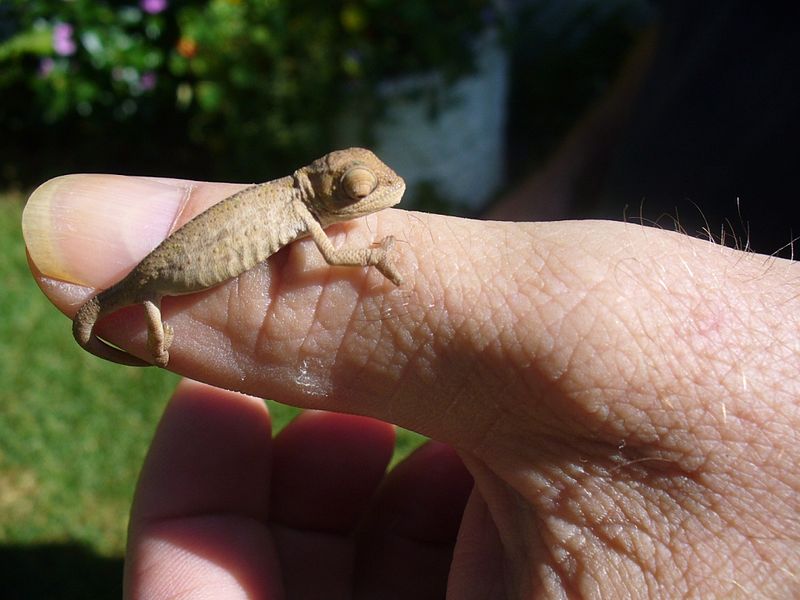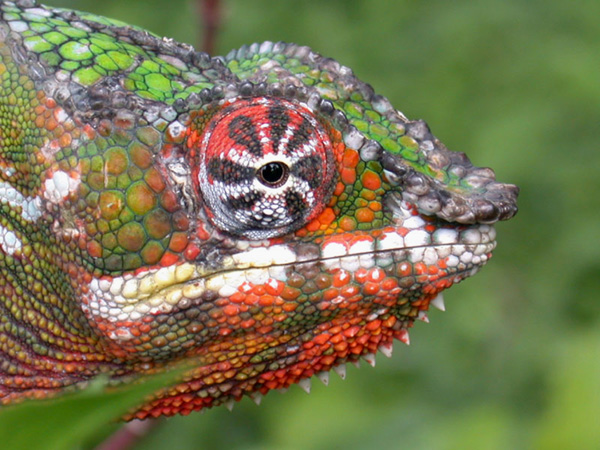
Category Archives: Chameleons
Feed SubscriptionThe Dwarf Chameleons – Notes on Captive Care and Natural History
This article is one of a series in which I will provide a brief introduction to both popular and rarely-kept amphibians, reptiles and invertebrates. I’ll cover such topics as unique habits in the wild, common mistakes or concerns in captive care, pet pros and cons, little-known husbandry tips and so forth. Detailed care articles will follow…until then, I would enjoy receiving your questions and comments. Today we’ll take a look at the Dwarf Chameleons (Brachypodion spp.). Read More »
Interesting Facts and the Care of the Senegal Chameleon
Today we’ll take another look at those oddest of lizards, the chameleons (Family Chamaeleonidae), followed by some tips on the care of the Senegal Chameleon (Chamaeleo senegalensis).
Eyes
The cone shaped torrents that enclose the chameleon’s eyes are actually made up of fused, overlapping sets of eye lids. By covering all but the eye’s pupil, they offer excellent protection to this most important organ.
Chameleon eyes contain far more visual cells than do our own, and can be rotated 180 degrees. Uniquely among all animals, the eyes can focus either independently (on different objects) or together.
Vision, Learning and Hunting Accuracy
When a chameleon focuses both eyes on an insect, it hits its target 9 out of 10 times. In laboratory situations, accuracy falls to 0 when 1 eye is covered. However, by the second day hunting accuracy rises to 20%. On day 4, the one-eyed hunters successfully capture insects on 50% of their attempts.
Senses of Hearing and Smell
Chameleons do not hear well …like snakes, they detect air vibrations and low-pitched sounds only.
The Jacobsen’s organ, which allows many other reptiles to “smell” chemical particles in the air, is vestigial (much reduced) in chameleons. It is therefore assumed that they do not detect most odors.
Distribution
Madagascar is the center of chameleon diversity, with over 75 species, many endemic, living there. Neighboring Africa, despite being vastly larger, boasts only 100 or so species. Only 2 species make their homes in the Middle East, 2 in Europe and 2 in India and Sri Lanka.
At least 2 species of chameleon have established feral populations in foreign habitats. The veiled chameleon (Chamaeleo calyptratus) thrives in Florida, Hawaii and Mexico, while the Jackson’s chameleon (C. jacksonii) has been breeding on Hawaii since the 1970’s and has recently been discovered in California.
The Senegal Chameleon, Chamaeleo senegalensis
Hailing from tropical West Africa (Senegal to Cameroon), this dark-spotted, tan to olive chameleon inhabits brushy savannas and forest edges. Often abundant and easy to collect, it has long been a pet trade staple.
Some Cautions
Despite its long history in captivity, the Senegal does not breed regularly, and presents some problems as a pet. Wild caught specimens should be avoided, as they are usually heavily parasitized and afflicted with stress related ailments.
Captive Environment
Senegal Chameleons need quite, heavily planted screen cages or an outdoor aviary , abundant UVB radiation and should be kept well-hydrated via frequent spraying or the use of a mister. An ambient temperature of 76F with a basking site of 85F and a nighttime dip to 69-70F suits them well.
Breeding
If you are lucky enough to obtain a breeding pair, you’ll have your hands full…healthy females may lay 20-70 eggs at a time, twice each year! Incubation time averages 6 months at 77 F, and sexual maturity may be reached by 5 months of age.
The Smooth Chameleon
The range of East Africa’s Smooth Chameleon overlaps that of the Senegal in Cameroon. Formerly classified as a subspecies, the smooth chameleon has now been given full species status as Chamaeleo laevigata.
Male Chameleon in Madagascar image referenced from wikipedia and originally posted by Mbz1
Veiled Chameleon in Madagascar image referenced from wikipedia and originally posted by Billybizkit
Chameleon Color Change: Camouflage and Advertising at the Same Time?
In direct contrast to popularly-held theories, researchers at Australia’s University of Melbourne believe that the need to rapidly signal other chameleons, and not the need to hide from predators, has driven the evolution of the amazing color-changing abilities possessed by these lizards. In a sense, the primary function of color change is to render the animals more conspicuous – the opposite of being well-camouflaged!
Camouflage
However, the need to camouflage still exerts an influence. By being able to affect color changes in a mere fraction of a second, the lizards lessen the chance that predators will notice them.
Earlier research at the University of Melbourne has also revealed that at least 1 species does endeavor to “match” the background upon which in rests. In fact, Smith’s dwarf chameleon actually alters the degree of color change it exhibits in response to the type of predator it faces (please see article below).
Other Possibilities: My Experience
I have noticed that, unlike most animals that display (male birds, for example, often sing for hours on end, even if when other birds are not visible), chameleons only flash messages when in the presence of possible rivals or mates. This would also seem to limit their exposure to predators.
Chameleons also display an incredible range of subtle color variations, most not visible to the human eye which, I believe, also assists in “getting their message across” as quickly as possible.
Further Reading
To learn more about new research regarding color change and predator avoidance, please see my article Chameleons and Camouflage.
Research Note – Chameleon Basking Behavior is affected by Vitamin D Needs
Panther chameleons (Furcifer pardalis) carefully regulate exposure to sunlight in accordance with their Vitamin D3 levels, states an article published in the May/June issue of Physiological and Biochemical Zoology.
Nutrient Levels Affect Behavior
 Chameleons with high Vitamin D3 levels (achieved through a diet of vitamin-supplemented crickets) limited their exposure to the sun, while those maintained on a vitamin-poor diet maximized basking time. Further analysis showed that, as regarded individual Vitamin D3 levels, the lizards were “…as effective as mathematically possible” in achieving optimal sun exposure. Vitamin D3 receptors in the brain are believed responsible for accessing vitamin needs and controlling basking behavior.
Chameleons with high Vitamin D3 levels (achieved through a diet of vitamin-supplemented crickets) limited their exposure to the sun, while those maintained on a vitamin-poor diet maximized basking time. Further analysis showed that, as regarded individual Vitamin D3 levels, the lizards were “…as effective as mathematically possible” in achieving optimal sun exposure. Vitamin D3 receptors in the brain are believed responsible for accessing vitamin needs and controlling basking behavior.
Basking or Diet?
I was most interested in this article because, although this point was not specifically addressed, it established that panther chameleons can be provided with adequate Vitamin D3 (at least in the short term) through dietary means. I have long questioned my observations that certain reptiles, typically thought to be entirely dependent upon UVB radiation (basking) for Vitamin D synthesis, are none-the-less sometimes able to obtain sufficient Vitamin D3 from their diets (please see the article referenced below).
Some Cautions
Information of the type established by this research has a way of taking on a life of its own once spread via the internet, so a few words of caution are in order.
Please bear in mind that the Vitamin D and UVB needs of reptiles vary widely from species to species, and perhaps even within populations of the same species. This research applies to a single species housed outdoors with access to full sunlight, and should not be used as other than a baseline for further experiments as regards other animals.
For now, it remains important to provide the heliothermic (basking) reptiles that you keep with an appropriate UVB bulb (or natural sunlight) and to use vitamin/mineral supplements judiciously. This is a quite important topic, and one fraught with misinformation…please write with questions concerning individual reptiles.
Further Reading
For information on an outstanding UVB bulb and recent tests concerning its output, please see my article on Zoo Med UVB Lamps.
I have written about related experiences with day geckos and red-eared sliders… please see my article Has Anyone Observed This? for further details.
Image referenced from Wikipedia and originally posted by Tom Junek.
 That Reptile Blog – Reptile, Amphibian and Exotic Pet Care and Information
That Reptile Blog – Reptile, Amphibian and Exotic Pet Care and Information
